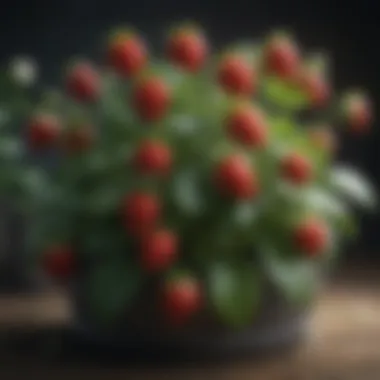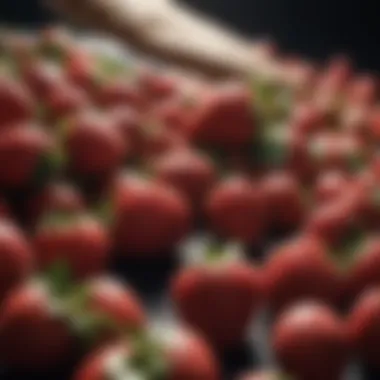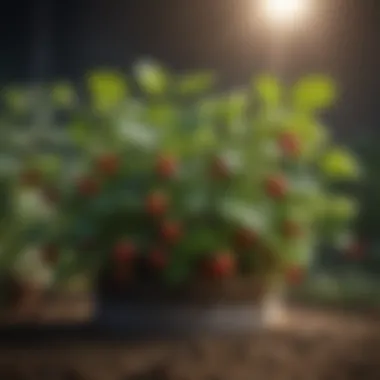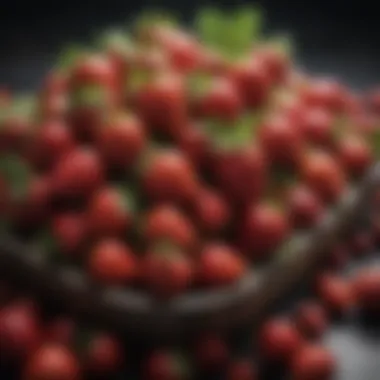Unlocking the Wonders of Annual Strawberry Plants: A Comprehensive Guide


Gardening Know-How
Annual strawberry plants are a delightful addition to any garden, offering not only delicious fruits but also a visual treat with their vibrant red berries against lush green leaves. Understanding the intricacies of cultivating these plants is essential for a bountiful harvest. From planting the right variety at the optimal time to providing adequate watering and sunlight, proper care is crucial. Furthermore, familiarizing oneself with potential pests and diseases that may affect strawberry plants can help preempt any issues, ensuring the plants thrive. Sourcing high-quality seeds or seedlings from reputable suppliers is the foundation of a successful strawberry garden.
Plant Care Guides
Taking care of annual strawberry plants involves a series of meticulous tasks to support their growth and productivity. Pruning, fertilizing, and mulching are vital components of nurturing healthy plants. Pruning helps maintain airflow and prevents diseases, while fertilizing provides essential nutrients for robust growth. Mulching not only retains moisture in the soil but also helps suppress weeds that could compete with the plants for resources. Regular maintenance, such as removing dead leaves and runners, promotes better fruit production and overall plant health.
Seasonal Gardening Tips
To optimize the yield of annual strawberry plants, aligning cultivation practices with seasonal variations is key. In the spring, focus on maintaining soil moisture and controlling weeds to encourage flower formation. Summer care involves adequate watering and monitoring for signs of pests. In the fall, prepare the plants for winter dormancy by reducing watering and applying a protective layer of mulch. Understanding the specific needs of strawberry plants throughout the seasons can result in a thriving garden year-round.
DIY Garden Projects
Enhancing the garden experience with DIY projects can elevate the aesthetics and functionality of the space. Building raised beds for strawberry plant cultivation not only improves drainage but also aids in pest control. Creating trellises or supports for trailing varieties ensures proper growth and easy fruit access. Incorporating drip irrigation systems can efficiently deliver water to plants while conserving resources. Experimenting with different garden projects allows for personalization and optimization of the strawberry gardening experience.
Introduction to Annual Strawberry Plants
Annual strawberry plants are a captivating subject within the realm of gardening, offering both novices and experts alike a delightful experience in cultivating these vibrant fruits. In this comprehensive guide, we will uncover the essential elements surrounding annual strawberry plants, providing valuable insights and guidance for optimum growth and yield.
Understanding the Basics
Delving into the basics of annual strawberry plants is crucial for successful cultivation. Firstly, the lifecycle of annual strawberry plants plays a pivotal role in understanding their growth journey. This key aspect sheds light on the stages these plants go through, from planting to harvesting, offering a deeper appreciation for their development.
Varieties of Annual Strawberry Plants
Exploring the diverse varieties of annual strawberry plants further enhances our understanding of this topic. Each variety brings its unique characteristics to the table, influencing factors such as taste, size, and yield. By delving into the specifics of these varieties, we can make informed decisions on which types to grow based on our preferences and gardening goals.
Ideal Growing Conditions


The ideal growing conditions for annual strawberry plants are crucial for their overall health and productivity. Factors such as sunlight, soil p H, and water requirements play a significant role in ensuring successful growth. Understanding and implementing these ideal conditions provide a solid foundation for nurturing thriving strawberry plants.
Benefits of Growing Annual Strawberry Plants
Embracing the cultivation of annual strawberry plants comes with a plethora of benefits. Firstly, the nutritional value of strawberries is exemplary, offering essential vitamins and minerals for a healthy diet. Economically, growing strawberries can be a lucrative endeavor, providing a source of income for enthusiasts. Moreover, the health benefits of consuming fresh strawberries are well-documented, making them a valuable addition to a balanced diet.
Planting and Caring for Annual Strawberry Plants
In the intricate world of annual strawberry plants, understanding how to plant and care for them is foundational. This section serves as a cornerstone in the comprehensive guide, offering essential insights into the meticulous process involved. Cultivating annual strawberry plants requires specific attention to detail, considering various elements such as site selection, soil preparation, and proper planting techniques.
Planting Techniques
Choosing the Right Location
Delving into the crucial aspect of selecting the optimal location for planting annual strawberry plants reveals its significance in ensuring a successful harvest. The choice of location directly impacts the plant's overall growth and fruit production. Opting for a site with ample sunlight exposure, well-draining soil, and protection from harsh winds is paramount. The unique characteristic of ideal locational selection lies in providing the plants with the necessary conditions to thrive, ultimately yielding bountiful strawberries during the growing season.
Preparing the Soil
Preparing the soil stands as a fundamental step in the planting process, contributing significantly to the plants' health and productivity. The key characteristic of well-prepared soil lies in its nutrient-rich composition and proper drainage capacity. By adequately amending the soil with organic matter and ensuring proper p H levels, gardeners can create an optimal environment for the plants to establish strong root systems. However, excessive fertilization can lead to nutrient imbalances, potentially affecting plant growth and fruit development.
Planting Methods
Exploring various planting methods sheds light on the diverse approaches available to growers when establishing their annual strawberry plants. The key characteristic of these methods lies in promoting adequate spacing between plants, allowing for proper air circulation and ease of maintenance. Depending on the preferred cultivation technique – such as traditional in-ground planting, raised beds, or container gardening – each method offers unique advantages and disadvantages. Selecting the most suitable planting method based on available space, resources, and gardening preferences is crucial for achieving optimal plant growth and fruit production.
Maintaining Healthy Plants
Sustaining the health of annual strawberry plants involves ongoing care and attention to key aspects such as watering, fertilization, and pest management. These practices are integral to promoting robust plant growth and mitigating potential risks that may impede fruit development.
Watering Strategies
Effective watering strategies play a pivotal role in ensuring the plants receive adequate moisture levels essential for growth and fruiting. The key characteristic of proper watering lies in maintaining consistent soil moisture without overwatering, which can lead to root rot. Implementing techniques such as drip irrigation or soaker hoses can help deliver water directly to the plant roots, minimizing water wastage and optimizing absorption.


Fertilization Tips
Providing the plants with the right balance of nutrients through proper fertilization is key to supporting healthy growth and maximizing fruit production. Fertilization tips focus on supplementing the soil with essential nutrients like nitrogen, phosphorus, and potassium, tailored to the specific requirements of strawberry plants at different growth stages. Over-fertilization poses the risk of nutrient build-up in the soil, potentially causing nutrient imbalances and adversely affecting plant health.
Controlling Pests and Diseases
Mitigating pest infestations and diseases is crucial for safeguarding the vitality of annual strawberry plants and preserving fruit quality. Implementing proactive pest control measures and disease management strategies is essential to prevent damage and ensure plant longevity. Integrated pest management techniques, organic pesticides, and regular inspections are effective approaches to controlling common pests and diseases without the need for harsh chemicals. However, overlooking early signs of infestation or disease can result in irreversible damage to the plants, affecting overall yield and plant vigor.
Optimizing Growth and Harvest
Maximizing Yield
Pruning Techniques
Pruning techniques are a fundamental aspect of ensuring optimal growth and yield when cultivating annual strawberry plants. By selectively removing certain parts of the plant, such as runners or older leaves, gardeners can redirect the plant's energy towards fruit production. This method helps improve air circulation, reduces the risk of disease, and encourages the development of larger and more flavorful strawberries. Implementing proper pruning techniques is crucial for maintaining plant health and maximizing the overall yield of the crop.
Protecting from Weather Elements
Protecting annual strawberry plants from adverse weather conditions is vital for their growth and productivity. Shielding the plants from excessive heat, strong winds, or heavy rainfall can prevent damage to the delicate fruits and foliage. Employing methods like installing shade cloth, windbreaks, or using row covers can help mitigate the impact of unfavorable weather on the plants, ensuring a successful harvest.
Encouraging Fruit Production
Encouraging fruit production in annual strawberry plants is essential for achieving a bountiful harvest. Techniques such as proper fertilization, adequate watering, and providing sufficient sunlight can stimulate flower development and fruit set. Additionally, incorporating pollinator-friendly practices, like planting bee-attractant flowers nearby, can enhance pollination and boost fruit production. By fostering a conducive environment for fruit formation, gardeners can enjoy a plentiful supply of succulent strawberries.
Harvesting and Storage
Determining Ripeness
Determining the ripeness of strawberries is a crucial skill that ensures the fruits are picked at their peak flavor and sweetness. By assessing factors such as color, firmness, and aroma, gardeners can identify when strawberries are ripe for harvest. Ripe strawberries should have a vibrant red hue, be moderately firm to the touch, and emit a fragrant aroma. Harvesting strawberries at the right level of ripeness guarantees a delightful eating experience.
Harvesting Best Practices


Adhering to best practices when harvesting strawberries is key to preserving the fruit's quality and extending its shelf life. Using sharp shears or scissors to snip the stem of the berry without causing damage ensures that each strawberry remains intact and fresh. Harvesting in the cool hours of the morning when temperatures are lower helps maintain the fruit's texture and flavor. Following proper harvesting techniques is essential for enjoying juicy and flavorful strawberries.
Storage Recommendations
Proper storage of freshly harvested strawberries is essential for prolonging their shelf life and retaining their flavor. Storing strawberries unwashed in a single layer in a breathable container lined with paper towels can help prevent moisture buildup and mold growth. Placing the container in the refrigerator's crisper drawer ensures the berries stay cool and retain their freshness for an extended period. Adhering to correct storage recommendations ensures that strawberries remain delicious for culinary use.
Troubleshooting Common Issues
Troubleshooting common issues is a vital aspect of this article as it equips readers with the necessary knowledge to address challenges that may arise during the cultivation of annual strawberry plants. By focusing on identifying and combating pests and diseases, gardeners can ensure the health and productivity of their strawberry plants, ultimately maximizing their yield and enjoying a successful harvest. Understanding how to troubleshoot common issues provides essential insights that enable gardeners to proactively protect their plants and prevent potential setbacks.
Dealing with Pests
Identifying Common Pests
In the realm of gardening, identifying common pests plays a crucial role in maintaining the well-being of annual strawberry plants. By recognizing signs of infestation early on, gardeners can implement timely and effective pest control measures to safeguard their plants from significant damage. Identifying common pests entails closely inspecting the plants for telltale symptoms such as leaf discoloration, wilting, or the presence of bugs. This proactive approach not only aids in preserving plant health but also helps gardeners intervene swiftly, preventing pest populations from spreading and causing extensive harm.
Natural Pest Control Methods
Natural pest control methods offer a sustainable and eco-friendly approach to managing pests without resorting to harsh chemicals. By utilizing natural predators, traps, companion planting, and organic repellents, gardeners can effectively control pest populations while minimizing harm to beneficial insects and the environment. Embracing natural pest control methods aligns with the principles of organic gardening and promotes a harmonious ecosystem within the garden. Integrating these methods into pest management strategies encourages a balanced and naturally resilient garden that fosters the health and vitality of strawberry plants.
Preventive Measures
Implementing preventive measures is paramount in maintaining the long-term health and vigor of annual strawberry plants. By incorporating practices such as crop rotation, proper plant spacing, and regular sanitation, gardeners can deter pests from establishing infestations and ensure the ongoing well-being of their plants. Preventive measures serve as a proactive defense mechanism that fortifies the garden against potential pest outbreaks and reduces the reliance on reactive pest control methods. Emphasizing prevention not only minimizes the need for drastic interventions but also cultivates a sustainable and resilient garden ecosystem that thrives in harmony with nature.
Addressing Diseases
Common Strawberry Plant Diseases
In the context of annual strawberry plant cultivation, understanding common diseases is fundamental to preemptively managing and mitigating potential health threats to the plants. Familiarizing oneself with prevalent diseases such as powdery mildew, gray mold, and leaf spot enables gardeners to identify symptoms early, take prompt action, and prevent disease escalation. Recognizing the distinct characteristics of each disease facilitates targeted treatment strategies and optimizes the chances of successful disease control. By addressing common strawberry plant diseases proactively, gardeners can uphold plant health, preserve yield potential, and sustain the overall vitality of the garden.
Effective Treatment Options
Equipping oneself with knowledge of effective treatment options empowers gardeners to respond decisively to disease outbreaks and safeguard the well-being of annual strawberry plants. From organic fungicides and cultural practices to biological control agents, a spectrum of treatment modalities exists to combat various strawberry plant diseases. Selecting the most suitable treatment based on the specific disease symptoms and plant conditions can significantly enhance treatment efficacy and mitigate disease progression. Understanding the nuances of different treatment options enables gardeners to tailor interventions to the unique needs of their plants, promoting targeted and successful disease management.
Preventative Strategies
Adopting preventative strategies is a proactive approach to fortifying annual strawberry plants against potential disease threats and enhancing their resilience to environmental stressors. By promoting plant health through measures such as proper irrigation, optimal nutrition, and adequate air circulation, gardeners can create an inhospitable environment for diseases to proliferate. Preventative strategies focus on bolstering plant immunity, improving soil health, and minimizing factors that contribute to disease development. By integrating prevention into their cultivation practices, gardeners can preemptively safeguard their strawberry plants, reduce disease incidence, and foster a thriving garden ecosystem that thrives in a state of health and vitality.







